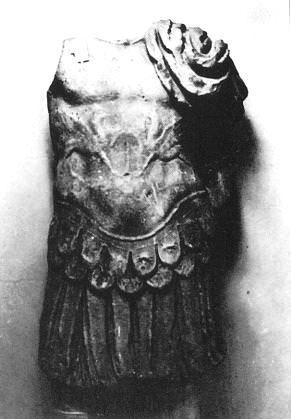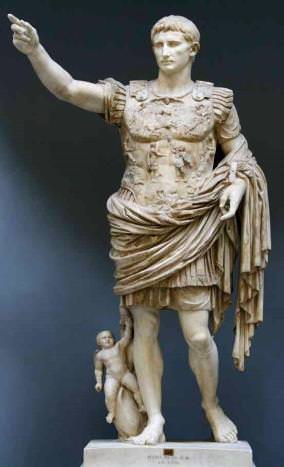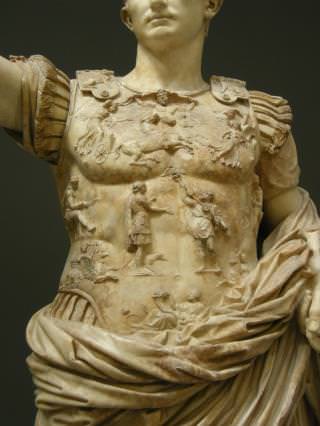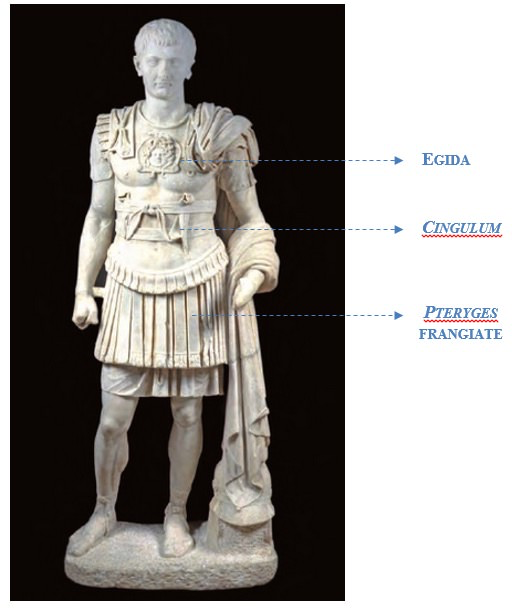Armoured statue
In the area identified as the forum of the Roman town of Cornus, in 1859 they made the chance find of an armoured statue (figs. 1-2). The square is situated on a plain to the South-East of the hill of Corchinas in Campu 'e Corra and was attributed to this place due to both its proximity to the acropolis in that centre and the discovery of a mosaic, three epigraphs and two statues. Only the torso of the armoured person is left and part of the lower limbs: he wears a tunic and armour over that. The armour portrays a small aegis with a Gorgon in its centre, two grifons in the central part opposite a central candlestick (see fig. 3). A double row of pteryges (fringes) and the flap cover the pelvis (fig. 2, see figs 4, 6). The work was dated between the I and II century A.D.
In Imperial Times, the armoured statue was mainly adopted to highlight military duties and merits to emphasise the warrior's charisma. The prototype of the imperial armoured statues, used until the late Empire period, is Augustus of Prima Porta (fig. 5). In Sardinia, there have been numerous finds of this type coming from important Roman centres (Sant’Antioco - fig. 6, Porto Torres, etc.).







Bibliografia
- V. ANGIUS in L. CARTA (a cura di), Città e villaggi della Sardegna dell’Ottocento, I, Abbasanta-Guspini, Nuoro 2006.
- M. CADARIO, Il linguaggio dei corpi nel ritratto romano, in E. LA ROCCA, C. PARISI PRESICCE, con A. LO MONACO (a cura di), Ritratti. Le tante facce del potere. Catalogo della mostra (Roma, Musei Capitolini 10 marzo-25 settembre 2011), Roma 2011, pp. 209-211.
- M. CADARIO, Statua loricata di Druso Minore, in E. LA ROCCA, C. PARISI PRESICCE, con A. LO MONACO (a cura di), Ritratti. Le tante facce del potere. Catalogo della mostra (Roma, Musei Capitolini 10 marzo-25 settembre 2011), Roma 2011, p. 227.
- C. B. FANTAUZZI, S. DE VINCENZO, Indagini archeologiche nell’antica Cornus (OR). Le campagne di scavo 2010 - 2011, The Journal of Fasti Online folder 2013-275, pp. 1-16.
- G. MANCINI, Le statue loricate imperiali, in Bullettino della Commissione Archeologica Comunale di Roma, L, 1923, pp. 151-204.
- A. MASTINO, Cornus nella storia degli studi con un catalogo delle iscrizioni rinvenute nel territorio del comune di Cuglieri, Cagliari 1984, pp. 62-64, 109-110.
- P. MELONI, La Sardegna romana, Sassari 1975, pp. 243-246.
- C. SALETTI, La scultura di età romana in Sardegna: ritratti e statue iconiche, in Rivista di Archeologia, XIII, 1989, pp. 76-100.
- G. SPANO, Scoperta di una statua colossale di marmo in Cornus, in Bullettino archeologico sardo, 5, 1859, pp. 170-172.
- G. SPANO, Doni fatti al R. Museo, in Bullettino archeologico sardo, 6, 12, 1860, pp. 181-182.
- G. SPANO, Storia e descrizione dell’antica città di Cornus, in Bullettino archeologico sardo, 10, 4, 1864, pp. 113-119.
- A. TARAMELLI, Cuglieri. Ricerche ed esplorazioni nell’antica Cornus, in Atti dell'Accademia Nazionale dei Lincei. Notizie degli scavi di antichità, 15, pp. 285-231.
- R. ZUCCA, Osservazioni sulla storia e la topografia di Cornus, in AA. VV., Ampsicora e il territorio di Cornus. Atti del II Convegno sull'archeologia romana e altomedievale nell'Oristanese (Cuglieri, 22 dicembre 1985) = Mediterraneo tardoantico e medievale. Scavi e ricerche, 6, Taranto 1988, pp. 31-57.
- R. ZUCCA, I culti pagani nelle civitates episcopali della Sardinia, in P. G. SPANU (a cura di), con la collaborazione di M. C. OPPO e A. BONINU, Insulae Christi. Il cristianesimo primitivo in Sardegna, Corsica e Baleari = Mediterraneo tardoantico e medievale. Scavi e ricerche 16, Oristano 2002, pp. 37-56.

 VR
VR